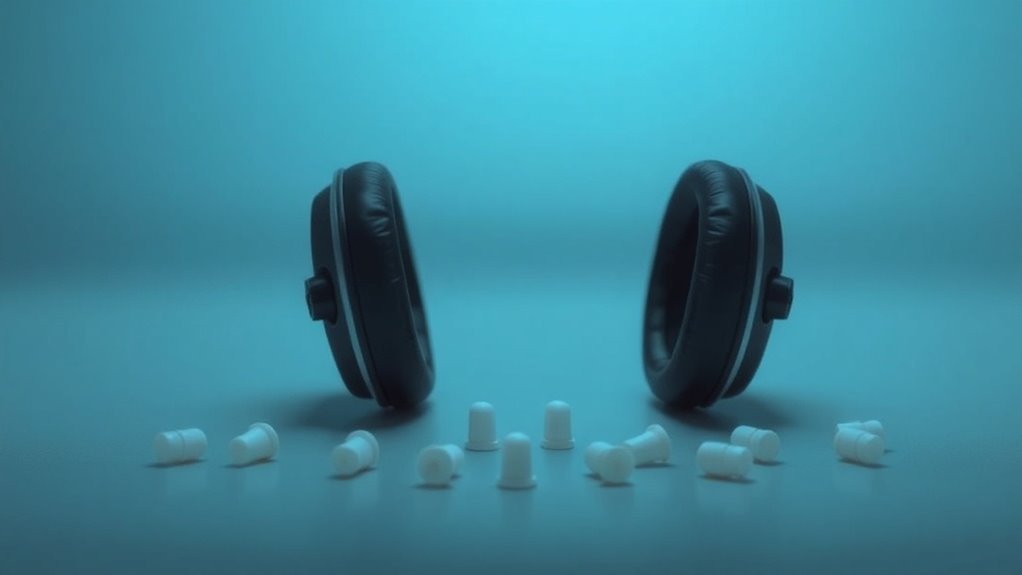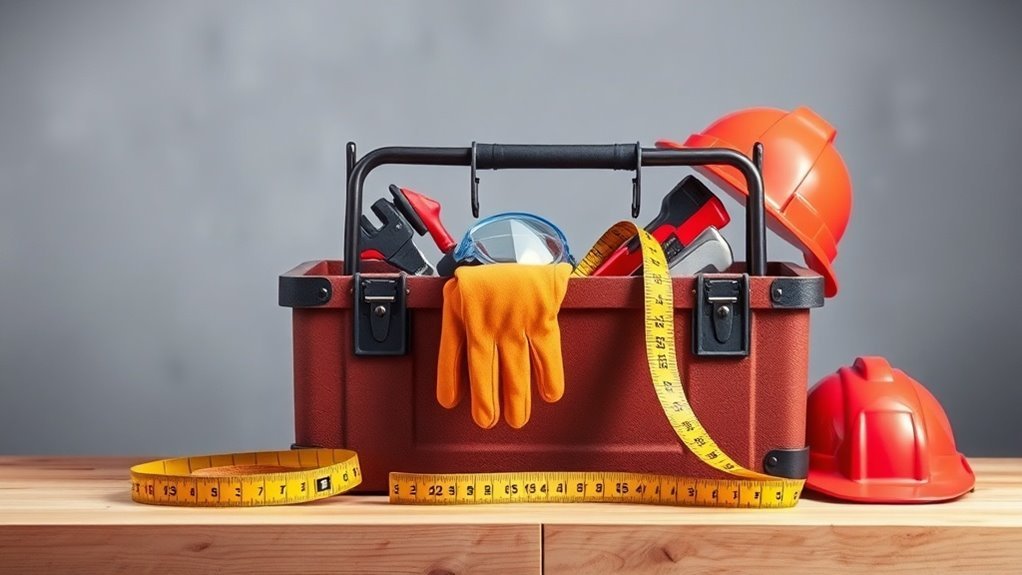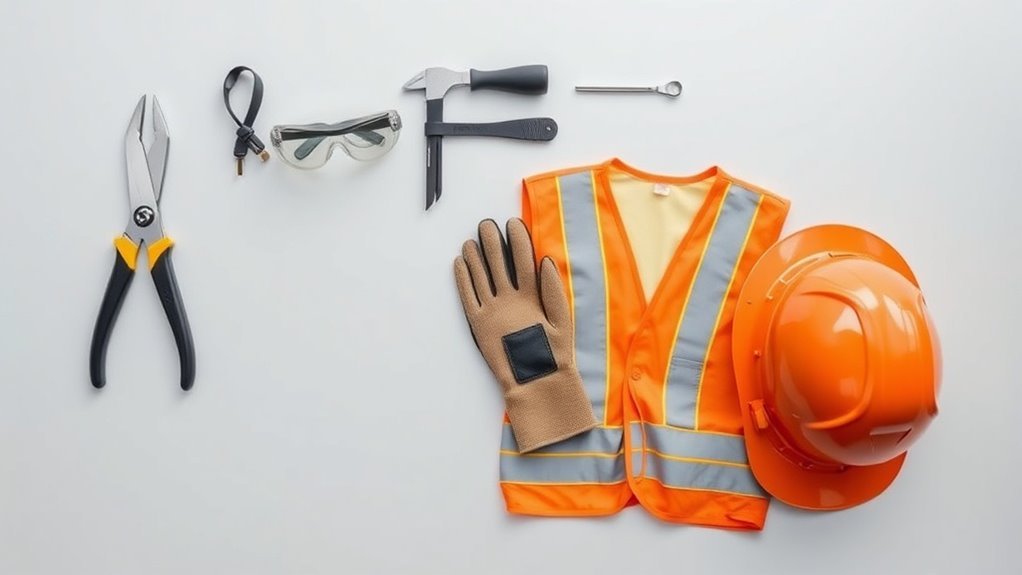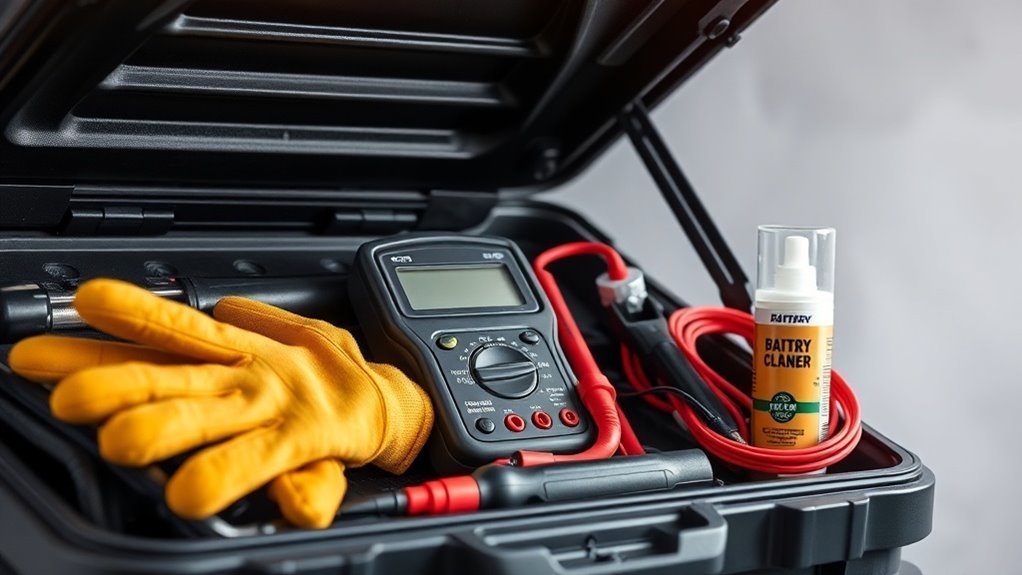Noise Protection: How Ear Muffs and Plugs Work

Noise protection is essential for your hearing health, especially in environments with loud sounds. Ear muffs cover your ears with padded cups that create a seal, considerably reducing noise exposure. Ear plugs fit snugly in your ear canal, blocking sound waves effectively. Both are designed to diminish harmful noise levels and protect against hearing loss. Wearing them can improve focus and reduce stress. Discover more about their benefits and proper use.
Key Takeaways
- Ear muffs provide a cushioned seal around the ears, effectively reducing noise exposure in loud environments like workplaces or concerts.
- Ear plugs fit snugly in the ear canal, creating a barrier that dampens sound waves before they reach the eardrums.
- Both ear muffs and plugs lower sound intensity, protecting against harmful noise levels above 85 dB, which can lead to hearing loss.
- Made from materials like foam or gel, ear muffs ensure comfort and durability, while silicone or memory foam ear plugs enhance noise isolation.
- Proper fit is crucial for both types; ear muffs need a tight seal, while ear plugs should sit comfortably yet securely in the ear.
The Importance of Noise Protection
Noise is an omnipresent threat to your hearing health, making noise protection essential. Prolonged exposure to loud sounds can lead to irreversible damage, such as tinnitus or permanent hearing loss.
You mightn’t realize it, but everyday environments—like busy streets, concerts, or even your workplace—can pose risks to your ears. Protecting your hearing doesn’t just enhance your quality of life; it also prevents future health issues related to noise exposure.
Wearing ear muffs or plugs can considerably reduce the volume you’re subjected to, allowing you to enjoy everyday activities without fear of compromising your hearing. Don’t underestimate the importance of taking care of your ears—investing in noise protection now can preserve your hearing for years to come.
Types of Noise Pollution

Sound pollution comes in various forms, each affecting your environment and well-being differently. You might encounter industrial noise from factories, which can disrupt your concentration and increase stress.
Transportation noise, whether it’s from cars, trains, or airplanes, can invade your quiet spaces, making it hard to relax or sleep.
Then there’s recreational noise, like loud music or parties, which can be enjoyable in moderation but annoying when excessive.
Construction noise can also create significant disturbances, especially if you live near ongoing projects.
Each type of noise pollution not only irritates but can lead to long-term health issues like hearing loss or heightened anxiety. Understanding these different forms helps you recognize the importance of noise protection in daily life.
Understanding Decibels
To really grasp noise protection, you need to understand decibels.
This scale measures sound intensity and can help you recognize how different levels of noise impact your hearing.
Decibel Scale Explained
The decibel scale, a logarithmic unit used to measure sound intensity, plays an essential role in understanding how we perceive different levels of noise. Each increase of 10 decibels represents a tenfold increase in sound intensity.
For example, a whisper at 30 dB is much quieter than a conversation at 60 dB, which is already 1000 times louder.
In everyday life, normal sounds typically range from 30 dB (quiet library) to 90 dB (lawnmower). Anything above 85 dB is considered potentially harmful, especially with prolonged exposure.
Familiarizing yourself with the decibel scale can help you gauge the sounds around you and make informed decisions about noise protection. This knowledge can improve your awareness of safe sound levels in your environment.
Impact on Hearing
Exposure to loud noises can seriously impact your hearing over time. It’s important to understand how decibels work because they measure sound intensity. Prolonged exposure to high decibel levels can lead to permanent hearing damage.
Here are some critical points to reflect on:
- Sounds above 85 decibels can start to cause hearing loss.
- Hearing damage can occur with just a few minutes of exposure to sounds above 120 decibels.
- Tinnitus, often described as a ringing in the ears, can result from exposure to loud noises.
- Wearing ear protection like muffs and plugs can considerably reduce your risk of hearing loss.
How Ear Muffs Work
Ear muffs provide a practical solution for those needing to shield their hearing from loud environments. They work by covering your ears with padded cups that create a seal, reducing noise exposure. Here’s a quick look at how they function:
| Feature | Function |
|---|---|
| Cup Design | Blocks sound waves |
| Padding | Guarantees comfort and a better seal |
| Adjustable Band | Fits securely on various head sizes |
When you wear ear muffs, sound waves are absorbed and decreased before they reach your ears. This is particularly helpful in industrial settings or during loud activities. Choosing the right pair can make a significant difference in protecting your hearing.
How Ear Plugs Function
To protect your hearing in noisy environments, ear plugs serve as a compact and effective alternative. These devices fit snugly into your ear canal, helping to block out harmful sound levels.
Here’s how they function effectively:
- Sealing: They create a barrier in your ear, reducing the amount of noise that enters.
- Absorbing: Many ear plugs can absorb sound waves, dampening their impact on your eardrum.
- Customized Fit: Some ear plugs are moldable, allowing for a tailored fit that enhances comfort and sound blocking.
- Ease of Use: You can easily insert and remove them, making them convenient for various noise levels.
Using ear plugs can be a simple yet essential step in preserving your hearing health.
Materials Used in Ear Protection
Choosing the right materials for ear protection is essential for effectiveness and comfort. Ear muffs typically feature cushioned cups made from foam or gel, which adapt to the shape of your ears, providing a snug fit. These coverings often use lightweight plastics that guarantee durability without being cumbersome.
On the other hand, ear plugs are commonly made from soft silicone or memory foam, which conform to your ear canal, enhancing noise isolation and comfort. Some ear plugs also have a wax coating for moisture resistance.
The materials you choose can impact not just sound attenuation levels but also your ability to wear them for extended periods. Therefore, selecting appropriate materials helps enhance your overall experience and protects your hearing more effectively.
Comparing Ear Muffs and Ear Plugs
While both ear muffs and ear plugs serve the same primary purpose of noise protection, they each offer unique advantages and disadvantages that might make one more suitable for your needs than the other.
Consider the following points when choosing:
- Comfort: Ear muffs can feel bulky, while ear plugs are more discreet and lighter.
- Noise Reduction: Ear muffs usually provide higher noise reduction ratings, ideal for loud environments.
- Durability: Ear muffs tend to last longer, while ear plugs may need frequent replacement.
- Adjustability: Ear muffs can be adjusted for fit, accommodating various head sizes, unlike standard-sized ear plugs.
Situations Requiring Noise Protection
You mightn’t realize it, but there are several situations where noise protection is essential.
Whether you’re in a bustling workplace, enjoying recreational activities, or working around industrial equipment, understanding when to use ear protection can make a big difference.
Let’s explore some of these scenarios and their specific requirements.
Workplace Safety Regulations
When workers are exposed to high noise levels, it’s essential to guarantee they’ve proper noise protection in place, as workplace safety regulations mandate specific measures to safeguard hearing.
These regulations typically address situations where you should prioritize hearing protection:
- Construction sites: Loud machinery and tools often produce harmful noise levels.
- Manufacturing plants: Equipment such as presses and conveyors can exceed safe noise limits.
- Music venues: Prolonged exposure to loud sounds from performances can be damaging.
- Airports: The sound from aircraft can create hazardous noise conditions.
Ignoring these regulations not only compromises your hearing but can also lead to financial penalties for employers.
Make sure you’re aware of the requirements in your workplace to keep yourself and your colleagues safe.
Recreational Noise Activities
Recreational activities, like attending concerts or participating in motor sports, often expose you to dangerously high noise levels. Whether you’re cheering for your favorite band or revving engines at a race, the sound can reach harmful decibels that put your hearing at risk.
Even occasional exposure can lead to temporary or permanent damage, making ear protection essential. Using ear muffs or plugs can greatly reduce the intensity of sound you experience, allowing you to enjoy these activities while safeguarding your hearing.
Industrial Equipment Exposure
While enjoying concerts and motorsports brings risk to your hearing, industrial environments pose even greater dangers due to constant exposure to loud machinery and equipment.
If you work in such settings, it’s essential to prioritize your hearing protection to prevent long-term damage. Here are some common industrial circumstances where noise protection is a must:
- Operating heavy machinery like excavators and bulldozers
- Working near assembly lines with constant clattering
- Maintenance tasks on generators or compressors
- Construction sites with loud power tools
You mightn’t notice the impact of noise exposure immediately, but over time, it can lead to irreversible hearing loss.
Using ear muffs or plugs effectively keeps your hearing safe in these environments. Don’t wait until it’s too late!
Tips for Proper Use and Fit
Using ear muffs and plugs effectively hinges on their proper fit and application.
First, always choose the right size; if they’re too loose or tight, they won’t provide adequate protection. For ear plugs, rotate and gently slide them into your ear canals until they feel snug but comfortable. If you feel discomfort, try another size or style.
For ear muffs, make sure that the seal around your ears is tight. Adjust the headband so they sit securely but not painfully.
Pay attention to the noise reduction rating (NRR) and select products that meet your needs for the specific environment. Additionally, when engaging in DIY projects, it’s crucial to consider the importance of respiratory protection as exposure to harmful materials can often accompany loud tasks.
Regularly inspect your gear for wear and tear, replacing any items that show signs of damage.
Proper maintenance guarantees peak performance.
The Impact of Noise Protection on Health
Using noise protection like ear muffs and plugs can be essential for preventing hearing loss. Not only do they shield your ears from harmful sounds, but they also help reduce stress by creating a quieter environment.
Let’s explore the positive health impacts of keeping noise at bay.
Hearing Loss Prevention
Noise exposure can seriously affect your hearing health, making protection essential for everyone, especially in loud environments.
Wearing ear muffs or plugs can help prevent irreversible damage to your hearing. Here are some key benefits of using them:
- Reduces sound intensity: Cuts down harmful noise levels greatly.
- Prevents fatigue: Protects your ears from constant loud sounds.
- Promotes better focus: Reduces distractions in work or recreational situations.
- Long-term savings: Prevents costly medical treatments for hearing loss later.
Stress Reduction Benefits
While many might think of ear muffs and plugs solely as tools for hearing protection, they also play a significant role in stress reduction.
By blocking out unwanted noise, they create a peaceful environment, allowing you to focus better and feel more relaxed. In today’s fast-paced world, constant noise can be overwhelming and trigger anxiety.
When you use ear protection, you give yourself the chance to recharge and escape from that chaos, helping you manage your stress levels.
Less noise means fewer distractions, improving your overall well-being.
Questions
Can I Use Ear Protection With Hearing Aids?
Yes, you can use ear protection with hearing aids. Just make certain the ear protection fits comfortably over or around your hearing aids, and consult your audiologist for recommendations on suitable options that won’t hinder your hearing.
How Often Should I Replace Ear Muffs or Plugs?
You should replace ear muffs or plugs about every six months, or sooner if they start losing their superhuman sound-dampening powers. Regular replacements guarantee you’re protected from noise like a knight in shining armor!
Are Custom Ear Plugs Worth the Cost?
Yes, custom ear plugs are worth the cost if you want superior comfort and protection. They fit perfectly to your ears, enhancing effectiveness and making them ideal for long-term use, especially in noisy environments.
Do Ear Muffs Work for Different Head Sizes?
Yes, ear muffs work for different head sizes. They’re often adjustable, ensuring a snug fit. You should always try them on, as individual comfort can vary considerably, impacting their effectiveness in blocking noise.
Can Children Use Adult Ear Protection Devices?
Yes, children can use adult ear protection devices, but it’s essential to guarantee they fit properly. Ill-fitting ear protection may not provide adequate noise reduction. Consider child-specific options for better comfort and effectiveness.
Conclusion
In summary, using ear muffs or plugs can make a real difference in protecting your hearing. Did you know that prolonged exposure to noise levels above 85 decibels can lead to permanent hearing loss? By taking noise protection seriously, you can lower your risk and enjoy a healthier life. Remember, whether you’re at a concert or using power tools, don’t underestimate the importance of keeping your ears safe every day.






